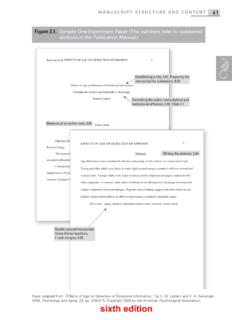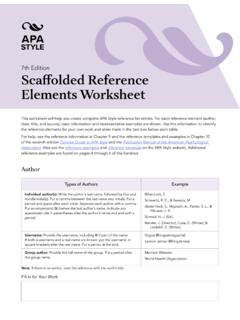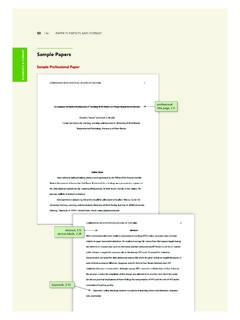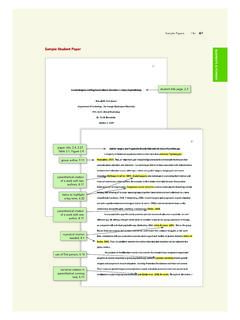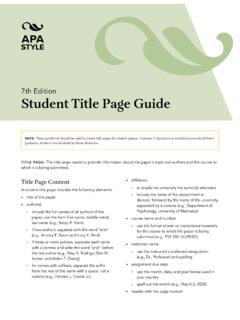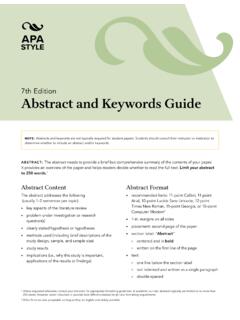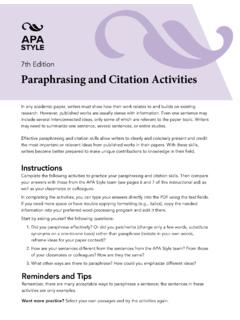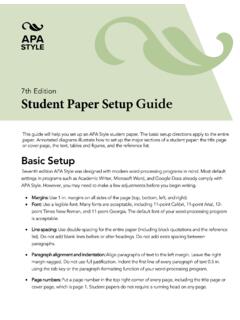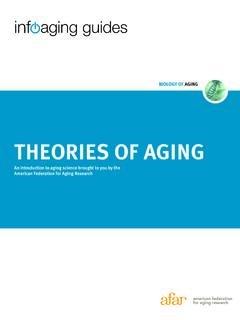Transcription of Sample Paper: One-Experiment Paper - APA Style
1 Running head: EFFECTS OF AGE ON DETECTION OF EMOTION1 Effects of Age on Detection of Emotional InformationChristina M. Leclerc and Elizabeth A. KensingerBoston CollegeAuthor NoteThis research was supported by National Science Foundation Grant BCS 0542694 awarded to Elizabeth A. concerning this article should be addressed to Christina M. Leclerc, Department of Psychology, Boston College, McGuinn Hall, Room 512, 140 Commonwealth Avenue, Chestnut Hill, MA 02467. Email: M. Leclerc and Elizabeth A. Kensinger, Department of Psychology, Boston Notearch was supported by National Science Foundation Grant BCS 0542694 beth A.
2 Concerning this article should be addressed to Christina M. Leclerc,sychology, Boston College, McGuinn Hall, Room 512, 140 Commonwealthut Hill, MA 02467. Email: Leclerc and Elizabeth A. Kensinger, Department of Psychology, Writing the abstract, a title, ; Preparing the manuscript for submission, the author name (byline) and institutional affiliation, , Table manuscript, Times Roman typeface, 1-inch margins, of an author note, OF AGE ON DETECTION OF EMOTION2 AbstractAge differences were examined in affective processing, in the context of a visual search task.
3 Young and older adults were faster to detect high arousal images compared with low arousal and neutral items. Younger adults were faster to detect positive high arousal targets compared with other categories. In contrast, older adults exhibited an overall detection advantage for emotional images compared with neutral images. Together, these findings suggest that older adults do not display valence-based effects on affective processing at relatively automatic : aging , attention, information processing, emotion, visual searchMANUSCRIPT STRUCTURE AND CONTENT41 Figure One-Experiment Paper (The numbers refer to numberedsections in the Publication Manual.)
4 Paper adapted from Effects of Age on Detection of Emotional Information, by C. M. Leclerc and E. A. Kensinger,2008, Psychology and aging , 23, pp. 209 215. Copyright 2008 by the American Psychological editionSAMPLE PAPERS42 EFFECTS OF AGE ON DETECTION OF EMOTION3 Effects of Age on Detection of Emotional InformationFrequently, people encounter situations in their environment in which it is impossible to attend to all available stimuli. It is therefore of great importance for one s attentional processes to select only the most salient information in the environment to which one should attend.
5 Previous research has suggested that emotional information is privy to attentional selection in young adults ( , & Tapia, 2004; Nummenmaa, Hyona, & Calvo, 2006), an obvious service to evolutionary drives to approach rewarding situations and to avoid threat and danger (Davis & Whalen, 2001; Dolan& Vuilleumier, 2003; Lang, Bradley, & Cuthbert, 1997; LeDoux, 1995).For example, Ohman, Flykt, and Esteves (2001) presented participants with 3 3 visualarrays with images representing four categories (snakes, spiders, flowers, mushrooms).
6 In half the arrays, all nine images were from the same category, whereas in the remaining half of the arrays, eight images were from one category and one image was from a different category ( , eight flowers and one snake). Participants were asked to indicate whether the matrix included a discrepant stimulus. Results indicated that fear-relevant images were more quickly detected than fear-irrelevant items, and larger search facilitation effects were observed for participants who were fearful of the stimuli. A similar pattern of results has been observed when examining the attention-grabbing nature of negative facial expressions, with threatening faces (includ ing those not attended to) identified more quickly than positive or neutral faces (Eastwood, Smilek, &Merikle, 2001; Hansen & Hansen, 1988).
7 The enhanced detection of emotional information is not limited to threatening stimuli; there is evidence that any high-arousing stimulus can be detected rapidly, regardless of whether it is positively or negatively valenced (Anderson, 2005;Anderson, 2005; Calvo & Lang, 2004; Carretie, Hinojosa, Marin -Loeches, Mecado,ant stimulus. Results indicated that fearr-rrrelevant images were more quickly detected than elevant items, and larger search facilitation effects were observed for participants who aaarful of the stimuli.)
8 A similar pattern of results has been observed when examining the n-grabbing nature of negative facial expressions, with threatening faces (includ-ing those nded to) identified more quickly than positive or neutral faces (Eastwood,Smilek, Hansen&Hansen,1988). The enhanced detection of emotional information is ited to threatening stimuli; there is evidence that any high-arousing stimulus can be d rapidly, regardless of whether it is positively or negatively valenced (Anderson,((2005;55 EFFECTS OF AGE ON DETECTION OF EMOTION4 Calvo & Lang, 2004; Carretie et al.)))
9 , 2004; Juth, Lundqvist, Karlsson, & Ohman, 2005;Nummenmaa et al., 2006).From this research, it seems clear that younger adults show detection benefits for arousing information in the environment. It is less clear whether these effects are preserved across the adult life span. The focus of the current research is on determining the extent to which aging influences the early, relatively automatic detection of emotional of the brain thought to be important for emotional detection remain relatively intact with aging (reviewed by Chow & Cummings, 2000).
10 Thus, it is plausible that the detection of emotional information remains relatively stable as adults age. However, despite the preservation of emotion-processing regions with age (or perhaps because of the contrast between the preservation of these regions and age-related declines in cognitive-processing regions; Goodet al., 2001; Hedden & Gabrieli, 2004; Ohnishi, Matsuda, Tabira, Asada, & Uno, 2001; Raz,2000; West, 1996), recent behavioral research has revealed changes that occur with aging in the regulation and processing of emotion.
